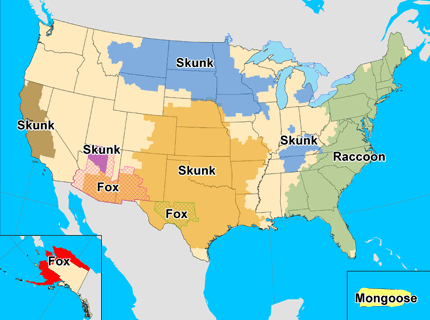Wild Animals
Wild animals accounted for 92% of reported cases of rabies in 2010. Raccoons continued to be the most frequently reported rabid wildlife species (36.5% of all animal cases during 2010), followed by skunks (23.5%), bats (23.2%), foxes (7.0%), and other wild animals, including rodents and lagomorphs (1.8%). Reported cases decreased among all wild animals during 2010.
Outbreaks of rabies infections in terrestrial mammals like raccoons, skunks, foxes, and coyotes are found in broad geographic regions across the United States. Geographic boundaries of currently recognized reservoirs for rabies in terrestrial mammals are shown on the map below:

Map of terrestrial rabies reservoirs in the United States during 2010. Raccoon rabies virus variant is present in the eastern United States, Skunk rabies in the Central United States and California, Fox rabies in Texas, Arizona, and Alaska, and Mongoose rabies in Puerto Rico.
Get email updates
To receive email updates about this page, enter your email address:
Contact Us:
- Centers for Disease Control and Prevention
1600 Clifton Rd
Atlanta, GA 30333 - 800-CDC-INFO
(800-232-4636)
TTY: (888) 232-6348 - New Hours of Operation
8am-8pm ET/Monday-Friday
Closed Holidays - cdcinfo@cdc.gov





